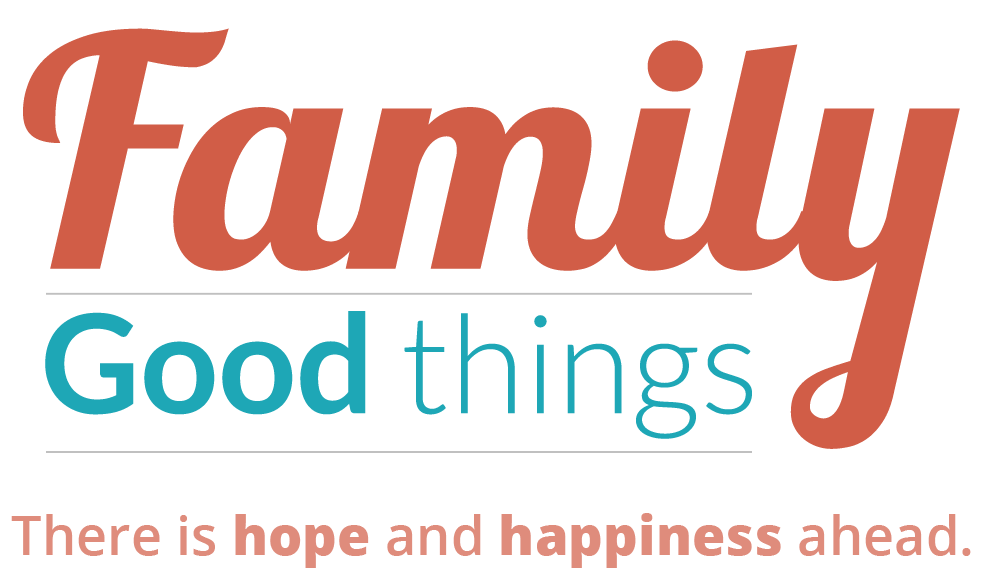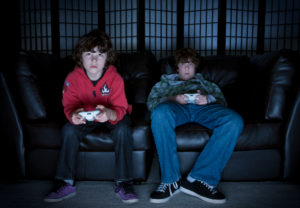by Tim Rarick | May 4, 2017 | Parenting
Ever wonder how punishment affects your child? Dr. Tim talks about some of the misconceptions we have about punishment in his brief video below.
For more on punishment, check out Dr. Tim’s full length article, “Can I Punish Character into My Child?“
Video Transcript
“So you don’t believe in disciplining your kids?”
I’ve heard this from many friends, students, and neighbors when I tell them that punishment usually doesn’t work in the way that most parents think. This question is also assuming that discipline and punishment are the same thing. They are not. Punishment is a form of discipline. Just like all apples are fruit, not all fruit are apples.
“But don’t your children have to learn consequences? How are you going to prepare them for the real world?”
Again, sincere questions but also coming from a false premise. Often times the punishments we actually give our children are not like the real world at all.
Let me give you an example. Recently on social media, I learned of a story of a child who had allegedly disrespected his teacher. The parents found out about this disrespect, and to punish him, made the child hold books over his head for an incredibly long period of time, repeating over and over “I won’t disrespect my teacher, I won’t disrespect my teacher!”
So in the real world, let’s say you get a little snippy with your spouse, or your child, or your co-worker. Do you have to hold something like your purse or your child’s bin of toys over your head and chant things like, “I won’t disrespect my child!” Is that how it is? Is that what it’s like in the real world? So at this point, you’re probably thinking,
“Well, what do I do instead?”
Great question. For more on discipline, check out my blog posts in the link below.
Please help us strengthen families by sharing this video with your friends and family! Likewise, to see more of Dr. Tim’s articles (as well as articles by Dr. Rob), please also check out the rest of our
blog and our
Facebook page.
by Tim Rarick | Nov 25, 2015 | Parenting

This article is part 3 in a 3-part series on punishment.
Not too long ago, my family and I went to the local library together to return our books and to renew our supply. All was well until we got back into the car to go home. Naomi (age 7) got into the backseat before Carter (age 12) and sat in Carter’s favorite spot. This ticked Carter off a bit and he started to get agitated with Naomi. He demanded that Naomi move, and she was more than happy to gloat about getting that coveted location.
Things escalated pretty quickly–as they often can in a family of passionate, emotional people–so Carter decided to use physical force to get his way. This slightly hurt Naomi’s body and really hurt her feelings. Being the protective Dad I am, I said to Carter: “What are you thinking?! It’s a spot in the car for a 5-minute car ride!” Then the lecture began.
About 10 words into the lecture, Carter plugged his ears! That really made my blood boil. I increased the volume of the lecture (not quite yelling yet), and then I caught myself. I got in the driver’s seat and drove home–still upset about Carter’s actions and the perceived disrespect. Little did he know that I was saving the lecture for later when I could get him to listen.
Let’s take a moment to reflect here.
Parents, I’m just going to say it like it is. I did so many more things wrong in this situation than Carter. First of all I’m 25 years older so I am more accountable. I can’t act or react in a way that makes me guilty of a greater offense than he is . . . which is what happened. Second, lectures rarely work in the way we hope — and I mean rarely! Third, the plugging of his ears was not intentional disrespect but a reaction to a useless pastime where I occasionally lecture and he tunes out. If anything, I should see this as a signal that I’m not teaching or connecting. This means it’s time to get off my soapbox, chill out, and think rationally again.
You may still be wondering, “So what did you do?”
I’m glad you asked. Here’s the rest of the story.
When we got home, Carter went straight to his room (I assumed he was upset about my mini lecture). I waited a few minutes–not having calmed down all the way–and knocked on his bedroom door. When the door opened, I started into a different type a lecture and I could tell he looked visibly upset. He stopped me and said: “Dad, I was praying for forgiveness and was about to come ask you and Naomi to forgive me but you interrupted me.” I felt like a piece of garbage.
We’ve tried to teach our children how to remedy a mistake over the years, and here was evidence it was working. It is only through effective teaching and guidance that can help children realize their mistakes and then self-correct. You can’t force remorse–which is what most punishments are attempting to do. Real remorse has to be natural and from within. Being sorry because you were caught and something bad happened to you doesn’t bring about real, heartfelt change.
What Carter needed was connection, not correction. (See the Parenting Pyramid for more details). Any type of punishment in this situation would have gotten in the way of what needed to happen and only made things worse.
We often want the quick fix that punishment provides. Connecting with and effectively teaching our children, on the other hand, require much more time and effort than any punishment demands of us.
Remember the Ping-Pong Parable? It would have been silly for me to punish Eleanor for whacking the table because I’d really be punishing her for having a pathetic teacher (me).
If you were taking tennis lessons and your instructor made you do 20 pushups every time you hit a backhand poorly, you wouldn’t improve your backhand. Instead, you’d just be more fearful when a ball came to your backhand. You’d be even more likely to mess up!
Yet we often do the same thing with children when they can’t control their emotions. And controlling emotions is much more difficult than hitting a backhand! (Trust me, I taught tennis for years.)
We think that some sort of punishment will teach emotional regulation, but instead it impedes it.
So before you use a threat, a lecture, a punitive time-out, a withdrawal of privileges, a grounding, or anything else that might fix the behavior temporarily, consider the following research-based *alternatives:
1. Adjust Your Expectations.
If a problem keeps happening, take the time to analyze the situation with your spouse. Do you need to make any adjustments? Many times parents have created a problem through poor teaching or unrealistic demands, and then the child is the one who gets punished. Take time to reflect on your expectations and be willing to make adjustments as needed. (Make sure you’re keeping the age of your child in mind as well. You shouldn’t expect the same from your 5-year-old that you expect from your 10-year-old.)
Example: Maybe your teen won’t clean his room because of your unreasonable demands. Instead of demanding his room is cleaned exactly to your specifications, find a healthy compromise. Your home will be better off with a slightly messy room and less fighting than it would be with a perfectly clean room.
2. Have Good Reasons and Teach Them.
Don’t have a rule just because you feel like it. Make sure you have good reasons behind what you ask of your children, and make sure your kids understand what those reasons are. (And for the record, “because I said so” isn’t a good reason.)
Example: If your child refuses to wear her seat belt, don’t threaten or bribe. You may have to get out of the car, connect with her, and explain why. Then show her by putting on your own seat belt.
3. Talk Less, Listen More.
Don’t assume you know what the child was thinking, feeling, or deciding. Ask and observe without interrogating! Listen to, acknowledge, and accept feelings. Try to put yourself in their shoes. It’s likely that the misbehavior is merely a symptom of a larger problem. As Stephen Covey teaches, seek to understand before you seek to be understood.
Example: When your child didn’t do his homework, take time to listen. There’s probably more to it than simply willful rebellion. Maybe they’re struggling with the subject or having other difficulties that need to be addressed.
4. Counsel Together.
Find a time when you’re both rational to talk with your children. (This probably won’t be while the conflict is happening.) State your own needs, and ask for their help in finding solutions. Determine rules together. Hold family meetings.
Example: If your teen keeps breaking curfew, decide on a time to come together and talk about the issue. Work together to determine the best solution.
5. Take Your Own Time-out.
Get out of there before you lose it. Explain to the child what you are doing so they know you aren’t just withdrawing love. This is a great example for children to learn how to deal with emotions and have the right kind of time-outs.
Example: When you’re starting to get overwhelmed or frustrated, take time to go for a run, cry, take a shower, or whatever you need to do to cool down.
By the way, bribes don’t work either. It’s just candy-coated control. For more on this see: Can I Bribe Character into My Child? Every disciplining strategy or technique can be measured against the following questions: Is this a “working-with” or “doing-to” approach? Is this more focused on teaching or correction? Am I keeping the long view of character or the short view of behavior in mind?
Learning Process
As evident by my example, we are always learning. Now that you have a few alternatives to punishment, put them into practice! It won’t come all at once, because good parenting is a process. When you start to get discouraged and fall into habits of punishing, remember: there are other options. You can do this!
*Points were largely taken from Unconditional Parenting,Twenty Alternatives to Punishment, and Positive Discipline.
Please help us strengthen families by sharing this article with your friends and family! Likewise, to see more of Dr. Tim’s articles (as well as articles by Dr. Rob), please also check out the rest of our
blog and our
Facebook page.
by Tim Rarick | Nov 19, 2015 | Parenting

This article is part 2 in a 3-part series on punishment.
Punishing and threatening my children is my go-to method. What do I do instead?!
I have no idea.
Kidding!
One parenting expert responds to this question by saying: “What’s the alternative? Such a question is more complicated than it seems because there isn’t one particular practice that serves as a replacement for punishments and rewards.”
What I will be suggesting is the creation of an entirely different view of the parent-child relationship. The “alternative,” in other words, doesn’t consist of specific techniques; it consists of a new lens and truth-based principles.
Keep in mind that there is no quick and easy answer to this. (This really needs to be in a book form rather than an article.) In our buy-now-pay-later world, it’s easy to want happy, obedient children — and to want them now.
However tempting it is, our child won’t be helped by quick, behavior-focused solutions. In my first blog post, Parenting isn’t Rocket Science…it’s Harder! I warned against this quick-fix approach to parenting. Most punishment is like a credit card — get the behavior now and pay later with interest.
Our Discipline Motives
So what is it that motivates us to threaten, punish, and otherwise coerce our kids? Often, we want to fix behavior so we can feel like successful parents. We let those behavioral indicators impact how we feel about ourselves and our children, even when those indicators aren’t the healthiest and most accurate measuring tool.
With threats, bribes, and punishments, we can almost force the indicator for how I’m doing as a parent–my child’s behavior–even though what we really hope for is deep, abiding character in our kids. When a child is compelled to start or stop doing certain behaviors–whether through withdrawing privileges or bribing–it is the parents that are rewarded for such methods. We get the desired action. You might say we get the evidence that tells us we’re doing okay as a parent.
But if we want to really help our kids, not just fix their behaviors, we may need to re-examine our discipline practices.
“Stop Whacking the Table!”
I mentioned in part 1 of this article that we often think that punishment is a form of teaching; we hope our children learn the lesson loud (sometimes literally) and clear. Yet too often, our punishments are corrective actions, not teaching moments. While the following story won’t show any dramatic crimes or mistakes (you can watch Supernanny for that), I hope it provides a backdrop to illustrate several principles or lessons about teaching.
Recently I was playing ping-pong in our basement with two of my daughters, Eleanor (age 4) and Naomi (age 7). (If you’ve guessed that I spent more time picking up balls off the floor rather than hitting them, you’d be right.) Naomi was on one side of table and Eleanor and I were on the other. I can serve balls right to Naomi’s sweet spot so she will often hit two or three balls in a row. With Eleanor, I have to drop a ball right in front of her and she waves her paddle around until she makes contact with the ball . . . sometimes with the backside of her paddle.
I noticed that Eleanor’s first attempt was to swing down at the ball and then whack the table on her follow through. So naturally, for the sake of the table and the paddle, I told her to stop doing that.
Pause the story!
Whenever possible, ask and invite rather than tell or command. Following this principle will show more respect for your children and acknowledge their ability to choose. So instead, I should have asked: “Eleanor, could you stop hitting the table?”
Okay. On with the show.
The next two attempts from Eleanor produced the same result. She actually hit the ball, but again the paddle came down on the table. So I thought that if I made it clearer, she would stop.
“Please don’t hit the table. Try it like this.” I swung my paddle from my side showing how to hit a forehand.
Pause again!
Telling and lecturing is not teaching. Many parents complain that they tell their kids what to do but still can’t get the desired behavior. They conclude that talking is ineffective. That is like saying “I type and I type and I can’t still can’t produce a good novel. Obviously typing is ineffective!” I think you get the point.
But there are more principles on the way.
Am I keeping her age and level of understanding in mind if I just repeat myself over and over? Do I really think that repeating something often while increasing in volume will really create a master ping-pong player? No. But this sort of “teaching” happens way too often.
It could be easy to assume that Eleanor is just being stubborn or obstinate.
In reality, her actions can indicate a lack of understanding, which means I need to learn to teach more effectively.
Back to ping-pong.
After demonstrating (modeling is key, but not enough) how to swing the paddle I noticed she was really trying, but struggled to hit the ball. Even though she had more success making contact with the ball swinging down, she still tried to do it the way daddy was doing it.
I decided to be more involved in the teaching moment and stood behind her. Then I put my hand over her hand that was holding the paddle, and as balls came our way we swung together. I also had fun with it so every time she hit the ball–with my help–I lifted her arm in the air and made a strange victory growl.
Interestingly, but not surprisingly, the bond between us increased and Eleanor started understanding what it felt like to swing the paddle correctly. I let her practice on her own and I saw improvement, but more importantly I saw her confidence grow in her ability to learn and my ability to teach.
You may think that this is a silly story that doesn’t help you know what to do with your teen who has defied you for the umpteenth time; or that hitting the ping-pong table with a paddle is not a big deal (which it isn’t). If this is the case, then perhaps you are missing point–the bigger picture. Learning to control emotions is more difficult than learning to hit a ball. No punishment ever taught emotional regulation.
I’ll give a more serious example in part 3, Lessons They Will Never Forget: Alternatives to Punishment and show the negative effects of punishment and the positive effects of connecting, patience, and effective teaching.
Moral of the Story
But for now, the moral of the story is that we may need to adjust the way we view our child’s misbehavior. Are we really helping them understand how to handle things appropriately? Or are we just telling them to not hit the ball instead of the table?
Please help us strengthen families by sharing this article with your friends and family! Likewise, to see more of Dr. Tim’s articles (as well as articles by Dr. Rob), please also check out the rest of our
blog and our
Facebook page.
by Tim Rarick | Nov 5, 2015 | Parenting
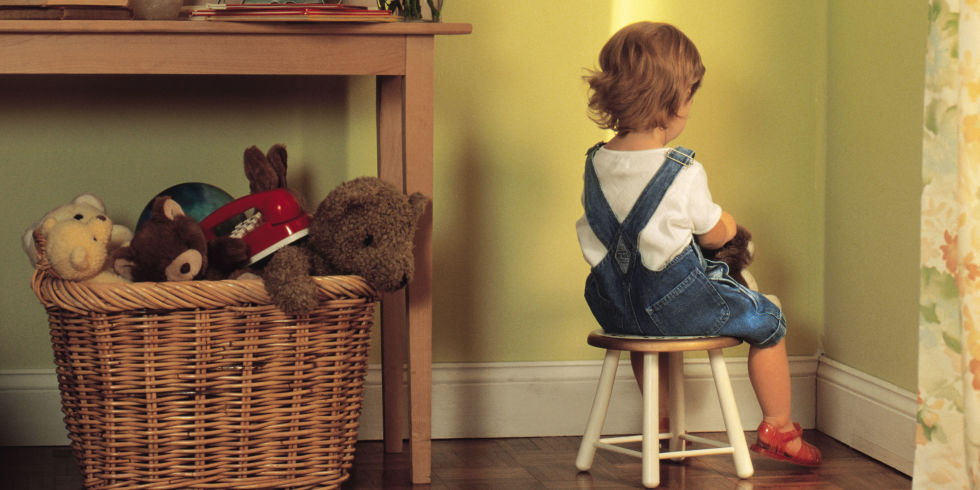
This article is part 1 in a 3-part series on punishment.
“So you don’t believe in disciplining your children?”
I’ve heard this from many friends, students, and neighbors when I tell them that punishment usually doesn’t work in the way most parents think.
This question is also assuming that discipline and punishment are the same thing. They are not. Punishment is a form of discipline. Just like all apples are fruit, not all fruit are apples.
“So you just let your kids do whatever they want?”
Yet another common question from doubting parents when I share the research on punishment. The assumption is that there are only two parenting philosophies: punitive or permissive. This is what we might call a false dichotomy.
“How can you have any order in your home without rules?”
Come on people! All I’m saying is that punishment is usually ineffective in producing what we really want in our children: character. Minimizing the frequency, the intensity, and the duration of your punishments doesn’t mean there are not rules, standards, and expectations in your home. Parenting expert Alfie Kohn explains that kids need structure, but they don’t need to be controlled.
“But don’t your children have to learn consequences? How are you going to prepare them for the real world?”
Again, a sincere question but also coming from a false premise. The premise is that punishing children will teach them about right and wrong when in reality, it often teaches them about power and self-interest. More on this in a moment.
I recently watched a video on Facebook of a boy who had to hold up his school books over his head for an incredibly long time because he disrespected his teacher. His mother made him repeat phrases such as: “I won’t disrespect my teacher.” “I love school.” “I don’t want to be homeless.” The entire time he was sobbing due to the pain in his arms. (And probably because of the soulless way in which his parents found amusement in their creative torture).
The false premise: The way you teach respect in the “real world” is to cause them pain and discomfort until they act respectful.
I purposefully emphasized the word act because punishment typically is great at temporarily fixing behavior. Children learn to simply perform the desired act so they won’t get in trouble again. But hearts haven’t changed. Morals weren’t internalized. Character wasn’t built.
Perhaps you think that this mother’s punishment is a great idea because it is related to the “crime.” One might even call it a logical consequence. After all, he mentioned his teacher and he was holding his textbooks above his head.
But in the “real world,” no one will require you to hold your spouse’s purse or wallet over your head when you say something you didn’t mean in a weak moment. You won’t have to hold your children’s bin of toys above your head when you let your stress get the better of you. And I doubt that chanting “I love my job” over and over when you’ve offended your McDonald’s coworker will get you pumped for your next shift.
What world are we raising our children on?
Ok. Maybe you think that this punishment was extreme. Maybe you think that putting your toddler or preschooler in time-out when they fight is a much more humane punishment. While it probably is more humane, it still doesn’t work . . . at least in the ways that matter.
The common assumption is that taking away a privilege will develop children who don’t fight with their siblings, or that grounding your teen will get him to become responsible. We parents may even attribute our good traits or character to the punishments we received growing up. For more on how your own upbringing gets in the way of how you see things read: Did You Really Turn Out OK?
Teachers and parents assume that clever consequences will change their child for the better and teach the intended lesson. Research and life experience tells us that this is simply not true. If what we really hope for is the formation of morals (a knowledge of right and wrong) and character (the part of us that dictates our desires, thoughts, and actions) then we need to discipline in ways that are consistent with our long term goals for our children.
If you are appropriately skeptical, let me share just a small snapshot from the research. One study found that “punishment is ineffectual over the long term as a technique for eliminating the kind of behavior toward which it is directed.”
Another study concluded that “parents who punish rule-breaking behavior in their children at home often have children who demonstrate higher levels of rule-breaking when away from home.”
Rather than asking: “What is right?” or “What kind of person I do I want to become?” or “How does ________ feel when I act this way?” Punishment typically leads children to ask:
“What do they want me to do, and what happens to me if I don’t do it?”
This creates self-interest rather than fostering a sense of morality.
“Hey, punishment works!”
Dr. Jane Nelson, author of Positive Discipline, cautioned us to “beware of what works.” It may work in the moment but with hidden costs. Dr. Nelson then shared the common long term consequences of the consistent use of punishment:
Resentment: “This is unfair. I can’t trust adults.”
Revenge: “They are winning now, but I’ll get even.”
Rebellion: “I’ll do just the opposite to prove I don’t have to do it their way.”
Retreat:
- Sneakiness — “I won’t get caught next time.”
- Reduced self-esteem — “I am a bad person.”
If punishment is your go-to method when your children misbehave, it doesn’t make you evil or a poor parent. It simply means that there is more learning and growing for us parents.
“So what should I do instead?”
Read part 2: Teaching vs. Punishment: Discipline Lessons from Ping-Pong.
Please help us strengthen families by sharing this article with your friends and family! Likewise, to see more of Dr. Tim’s articles (as well as articles by Dr. Rob), please also check out the rest of our
blog and our
Facebook page.
by Tim Rarick | Jun 25, 2015 | Parenting
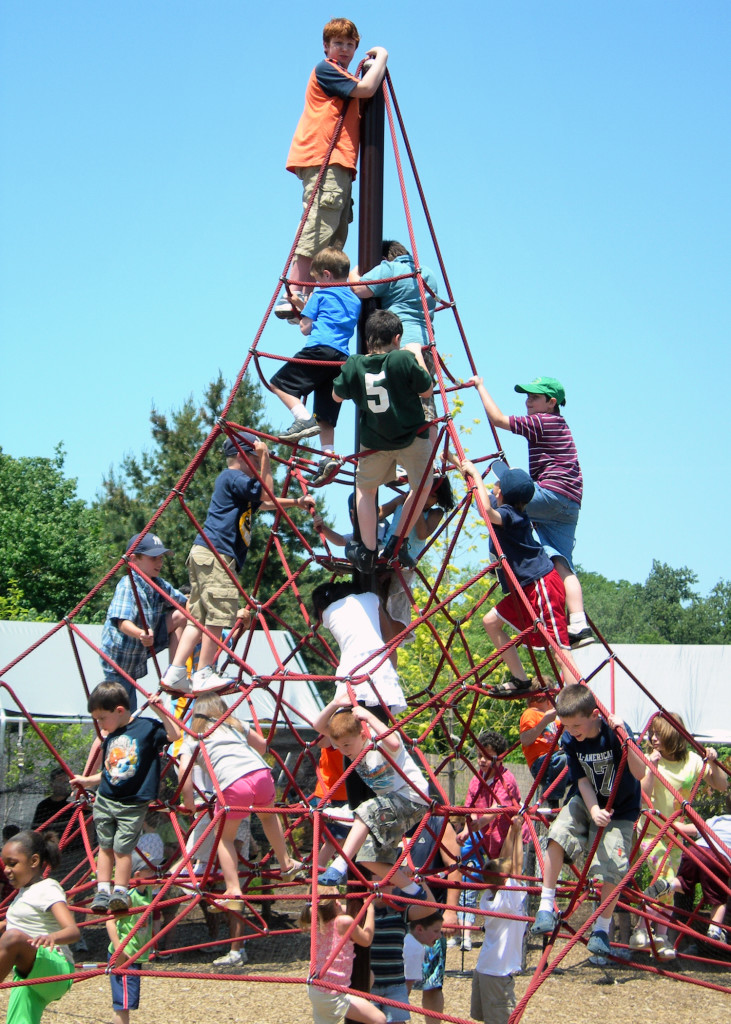
The Pitch
Have I got a deal for YOU! What if I told you that I have something that could fix ALL of your child’s misbehavior with a simple solution—regardless of their age! And if you act now, I’ll throw in some ways to improve both you and your marriage!
I know what you’re thinking.
“How am I supposed to trust a guy who overuses exclamation points? This sounds like a pyramid scheme.”
Your skepticism at this point is understandable and healthy. (At one point in my life I was a door-to-door salesman and I can be very persuasive if needs be . . . even without exclamation points.)
Back to pyramid schemes. This offer to transform you and your family is indeed based in pyramids. But before your enthusiasm causes you to start sharing this article with every person you’ve ever known on Facebook, you might want to keep on reading just to be sure there isn’t a catch.
I know you are dying to hear about the pyramid and you’ve probably even skipped ahead because you can’t take it anymore. But first, a musical metaphor.
Same Ole’ Song & Dance
Since the early days of pop music many, many songs pretty much use the same four chords over and over. This trend holds true for country, rock and other genres as well. The songwriter simply has to change the lyrics, tempo, and dynamics enough and BAM! You’ve got yourself a new song…sort of. A very simple example of this is found in singing the “ABC song” and “Twinkle, Twinkle Little Star.” Not only is it the same chord structure, it is the exact same melody. And many people have never even picked up on it!
(I know you are singing it right now just to test it.)
So what’s my point, you ask?
Far too much of the parenting advice found in books, talk shows, blogs (not this one, of course), and even from many experts has a common thread through it. They are saying the same thing but using different words, strategies, and techniques. In other words, they are all using the same four chords and making slight modifications. The “song” (advice) goes something like this (you can use the ABC tune if you’d like):
“Correct your child’s behavior now, demand respect and obedience.”
I break this theme down in more detail in a previous post: Parenting Isn’t Rocket Science…it’s Harder! Unfortunately, this focus on correction is a lot like building a pyramid upside down.
Who would build a pyramid upside down you ask? This guy. Is it even possible?
Not in the real world.

This is where the pyramid scheme comes in…
Parenting Up the Pyramid, Not Down
Ok. So it’s not actually a scheme, but a powerful yet simple parenting model shaped into a pyramid. The model originally came from Dr. C. Terry Warner—founder of the Arbinger Institute—and has loads of research to support it. The parenting pyramid helps parents to look past the behavior—and misbehavior—of their children and start asking the right questions.
If we start with a false premise or assumptions about our kids, then we will inevitably ask the wrong questions—thus, leading us further away from the actual problem.
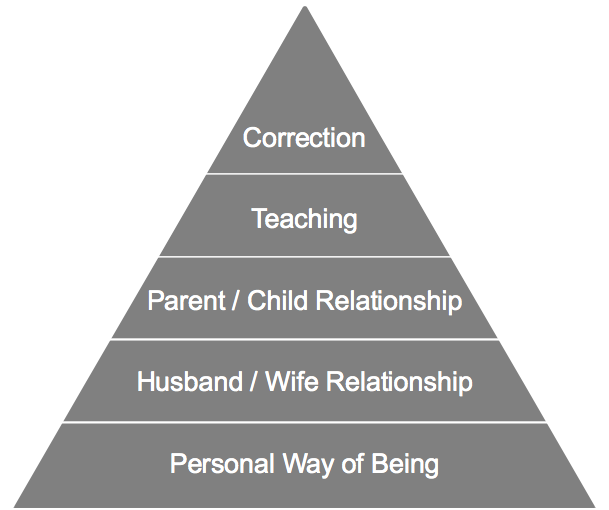
What Kinds of Questions are We Asking?
Consider the following questions I have recently received from well-meaning parents.
- How can we get my teenager to stop skipping class?
- What do we do to stop our toddler’s tantrums?
- How can I get my daughter to put down her smart phone?
- Our child won’t practice the piano. How can we fix that?
As mentioned in my Parenting Isn’t Rocket Science article, each of the above questions is focused on correction—the top of the pyramid. They are also, in essence, asking what to do when things go wrong. This is either flipping the pyramid on its head and starting with correction or assuming that all of the other pieces are firmly in place.
Now contrast the next set of questions with the previous set.
- How do we teach our children to be responsible?
- What do we do to help our children love each other?
- How do we help our children excel in the things they do?
- How do we help our children enjoy family activities?
These questions start from the overarching question: How do we help things go right?
Back to the Pyramid
Alright! I know you are dying to see how the pyramid is connected to all this! Me too. Let me break it down briefly and leave you with some homework. But don’t worry; my next posts will go deeper into each one of these levels.
Here’s a summary of the pyramid from the Arbinger Institute:
- Although correction is a part of parenthood, IT IS THE SMALLEST PART.
- The key to effective correction is effective teaching.
- The key to effective teaching is a good parent/child relationship.
- The key to a good parent/child relationship is a good husband/wife relationship.
- The key to a good husband/wife relationship is our personal way of being. Indeed, this quality affects every other aspect of the pyramid; that is why it is the deepest foundation.
Your Assignment
Now it’s time for the homework. With your spouse, think of a problematic behavior in one of your children. Decide carefully together how to ask the right questions — that is, making things go right. Then review the pyramid from the bottom up. Identity at least one thing you can do to improve in each of the bottom four levels. Then report back in the comments below.
The Catch
Remember, if it doesn’t work the first time, it’s not because this really is a scheme. It’s probably because this is a new way of looking at parenting. Don’t forget that improvement—in both you and your family—takes time. Step by step, you can build a happy and healthy family.
More pyramid good things to come!
